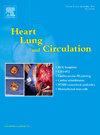Impact of Transcatheter Aortic Valve Implantation on Right Ventricular Function
IF 2.2
4区 医学
Q2 CARDIAC & CARDIOVASCULAR SYSTEMS
引用次数: 0
Abstract
Background
The prevalence and predictors of right ventricular (RV) dysfunction before and after transcatheter aortic valve implantation (TAVI) are not known. We aimed to document this and sought to identify specific RV echo thresholds, below which RV improvement was unlikely to occur.
Method
Consecutive patients who underwent TAVI between 2017 and 2021 at Macquarie University Hospital (MUH) were included if ≥2 RV functional parameters were available on baseline echo; tricuspid annular plane systolic excursion, tissue Doppler (S’) and/or RV fractional area change. Prevalence and predictors of baseline RV dysfunction were documented. Patients with a repeat echo performed at MUH at 1–3 months post-TAVI were included in further analyses to assess serial changes in RV function.
Results
Overall, 343 patients had an eligible baseline echo and 97 of these patients (28.2%) had RV dysfunction, pre-TAVI. These patients had significantly higher rates of atrial fibrillation, ischaemic heart disease, and chronic lung disease, than those without (p<0.05 for all). Of 239 patients with 1–3 month follow-up echo data, 66 of these had had baseline RV dysfunction; of these, 20 (30.3%) patients showed improvement and 46 (69.7%) patients showed persistent RV dysfunction. Thresholds with a greater than 90% predictive value for persistent RV dysfunction were identified for each baseline RV functional parameter: tricuspid annular plane systolic excursion <1.4 cm, S’<6, fractional area change <25%.
Conclusions
Baseline RV dysfunction was present in over a quarter of pre-TAVI patients and persisted at short-term follow-up in over two-thirds of such patients. There were clear thresholds to identify patients where RV recovery was unlikely, after TAVI.
经导管主动脉瓣植入术对右心室功能的影响。
背景:经导管主动脉瓣植入术(TAVI)前后右心室(RV)功能障碍的患病率和预测因素尚不清楚。我们的目的是记录这一点,并试图确定特定的右心室回声阈值,低于该阈值,右心室的改善不太可能发生。方法:纳入2017年至2021年在麦格理大学医院(MUH)连续接受TAVI的患者,如果基线回声可获得≥2个RV功能参数;三尖瓣环面收缩偏移,组织多普勒(S')和/或右心室分数面积改变。记录了基线右心室功能障碍的患病率和预测因素。tavi后1-3个月在MUH进行重复回声检查的患者被纳入进一步的分析,以评估RV功能的一系列变化。结果:总体而言,343例患者基线回声符合要求,其中97例(28.2%)患者在tavi前存在RV功能障碍。这些患者的房颤、缺血性心脏病和慢性肺病的发生率明显高于无tavi患者(结论:超过四分之一的tavi前患者存在基线RV功能障碍,超过三分之二的患者在短期随访中持续存在。有明确的阈值来确定TAVI后RV不可能恢复的患者。
本文章由计算机程序翻译,如有差异,请以英文原文为准。
求助全文
约1分钟内获得全文
求助全文
来源期刊

Heart, Lung and Circulation
CARDIAC & CARDIOVASCULAR SYSTEMS-
CiteScore
4.50
自引率
3.80%
发文量
912
审稿时长
11.9 weeks
期刊介绍:
Heart, Lung and Circulation publishes articles integrating clinical and research activities in the fields of basic cardiovascular science, clinical cardiology and cardiac surgery, with a focus on emerging issues in cardiovascular disease. The journal promotes multidisciplinary dialogue between cardiologists, cardiothoracic surgeons, cardio-pulmonary physicians and cardiovascular scientists.
 求助内容:
求助内容: 应助结果提醒方式:
应助结果提醒方式:


